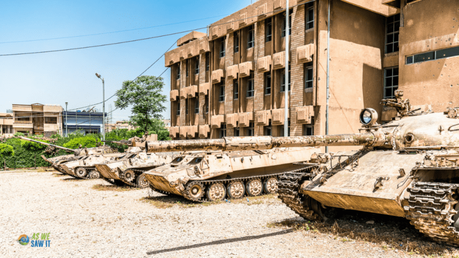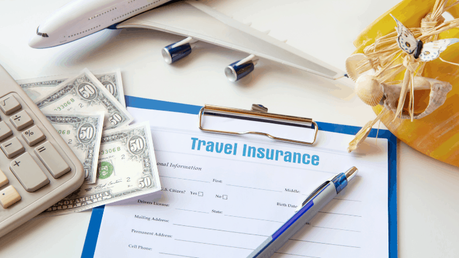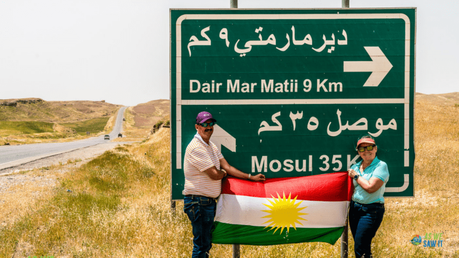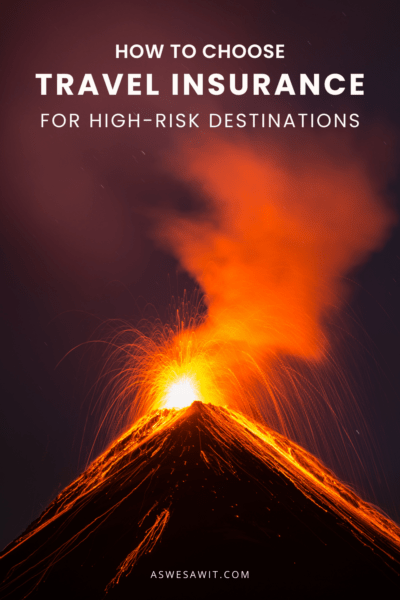Some might call me reckless. Northern Iraq, far-flung parts of Egypt, even a Balinese volcano on the brink of eruption-for me, the most exciting part of traveling is stepping out of my comfort zone. I thrive on experiencing unique cultures and places that exist nowhere else on Earth.
But still, there are risks involved with going off the tourist track. In places like these, where natural disasters, political unrest, and a lack of medical facilities are common, you need travel insurance for high-risk countries. Regular travel insurance usually isn't enough.
Let's get into why it's non-negotiable, what kind of coverage you need, and how to select the perfect policy for your trip.
Why is travel insurance for high-risk countries important?

Let's face it: Normal travel insurance often falls short in high-risk areas. In regions with high political unrest, natural disasters, or health crises, standard insurance may not provide the comprehensive protection you need.
For instance, if you find yourself in a country experiencing sudden civil unrest, regular insurance might not cover the costs of emergency evacuation or medical treatment if you're injured during a protest. High-risk travel insurance is designed to provide comprehensive coverage for unexpected events like trip cancellations, emergency medical evacuations, and lost belongings in volatile situations. Without this specialized coverage, you could face significant financial burdens.
Imagine needing urgent medical care in a foreign country without the funds to cover the expenses or having to pay out of pocket for a last-minute flight home due to escalating violence. High-risk travel insurance ensures you have the support you need when it matters most, so you can focus on your journey without unnecessary worry.
Essential Coverages for High-Risk Travel

When you're considering travel insurance for high-risk countries, you need to understand what these policies may cover. Here are the key areas that you need to examine:
1. Medical Expenses
One of the most critical aspects of travel insurance is medical coverage. This includes expenses for medical treatments, hospital stays, and emergency evacuations. In high-risk countries, medical facilities might be limited, and the quality of care can vary.
Imagine needing urgent medical attention in a remote area with few resources. Travel insurance ensures that you are covered for unexpected medical expenses, and this is especially crucial where healthcare resources are scarce.
2. Emergency Evacuation
Emergency evacuation coverage safeguards you in times of crisis. If you experience a severe medical emergency or encounter a natural disaster while in a high-risk country, this coverage ensures you can focus on recovery rather than logistical challenges.
Should a critical situation arise, your policy covers the cost of transporting you to the nearest medical facility equipped to handle your condition. Additionally, if necessary, you can be evacuated back to your home country for continued treatment. This becomes vital when local medical facilities are inadequate.
3. Trip Cancellation and Interruption
Trip cancellation and interruption coverage protect you if you need to cancel or cut short your trip due to unforeseen circumstances. This can include political instability, natural disasters, or other emergencies.
If you have to cancel your trip before departure or return home early, this coverage can reimburse you for non-refundable expenses, such as flights and accommodations. For instance, if a sudden political upheaval occurs, you can rest assured that you won't lose all your travel investments.
4. Lost or Stolen Belongings
Traveling to high-risk destinations increases the chance of losing or having your belongings stolen. High-risk travel insurance often covers the cost of replacing lost or stolen luggage, passports, and personal items.
This ensures you can quickly recover essential belongings and continue your trip without major disruptions. Imagine the relief of knowing your passport can be replaced swiftly if it's lost or stolen.
5. Personal Liability
Unforeseen incidents can happen anywhere, but the consequences can be more severe in high-risk environments. Personal liability coverage protects you from financial loss if you accidentally cause damage to someone else's property or injure another person.
This is particularly important in countries with different legal systems, where unexpected legal battles can arise. It can cover legal fees and compensation claims, ensuring you're prepared for any unexpected legal troubles.
6. Political and Security Risks
Traveling to regions with political instability or security threats requires careful consideration. High-risk travel insurance provides a crucial safety net by offering coverage for situations like terrorism, civil unrest, or political upheaval.
Should you find yourself in a dangerous situation, this coverage can pay for evacuation and other related expenses. High-risk policies can get you to safety quickly and reassure your loved ones back home.
7. Repatriation
Tragedy can strike anywhere, and having a plan in place is crucial. Repatriation coverage ensures that your remains are returned to your home country in the event of death while traveling.
This is especially important in high-risk regions where local funeral arrangements might be complex or emotionally overwhelming for your loved ones. While it's a difficult topic, this can be reassuring coverage during an incredibly challenging time.
Tips for Selecting the Best Travel Insurance Policy

When selecting travel insurance for high-risk countries, you should review the policy details carefully. Here are some tips to help you choose the right coverage:
1. Check the Coverage Limits
High-risk destinations often require higher coverage limits due to increased risks, so it's essential to ensure you're fully protected.
Start by looking at the coverage limits of different policies. Make sure the policy you choose offers adequate protection for medical expenses, emergency evacuation, and other critical areas.
2. Read the Exclusions
Insurance policies often come with exclusions that outline what isn't covered. Take the time to read these exclusions carefully to understand any limitations or conditions. Some policies might exclude coverage for specific high-risk activities or situations, so it is important to be aware of these details to avoid surprises later.
3. Verify the Provider's Network
Check if your insurance provider has a network of preferred healthcare providers or emergency services in the high-risk country you're visiting. Verify that reputable facilities and services are included so you can ensure that you receive prompt and quality care if needed.
4. Understand the Claims Process
Familiarize yourself with the claims process for your chosen policy. Know how to file a claim, what documentation is required, and the timeframes for submitting claims. Understanding the process in advance can help you navigate any issues more efficiently during your trip.
5. Consult a Travel Insurance Specialist
If you are unsure about which policy to choose, consider consulting a travel insurance specialist. These professionals can offer personalized advice and help you select a policy that meets your specific needs and travel plans. Their expertise can be invaluable in ensuring you have the right coverage for your adventure.
High-Risk Countries: Common Risks Travelers Face

To better understand the importance of travel insurance for high-risk countries, let's explore some of the challenges that travelers can experience:
1. Political Instability
Countries like Syria, Libya, and Venezuela face significant risks due to political instability. These regions often experience ongoing conflicts or civil unrest. Such conditions can disrupt travel plans and jeopardize safety.
If you're visiting a politically unstable region, look for policies that offer coverage for political evacuation and crisis response. Some insurers provide specialized coverage options for areas with government travel advisories.
2. Frequent Natural Disasters
Some countries are more susceptible to natural disasters like earthquakes, hurricanes, or volcanoes. Japan, the Philippines, and parts of the Caribbean are prime examples.
Ensure your policy includes emergency evacuation services and coverage for trip interruptions due to natural disasters. Imagine being on a Caribbean island with a hurricane approaching-having the right coverage can make all the difference!
3. Limited Healthcare Access
In some countries, healthcare facilities may be limited or of lower quality. Remote areas in Africa or South America, for example, might only offer basic medical services.
Comprehensive medical coverage and emergency evacuation are vital if you're heading to places like these. You'll want to be able to access necessary medical care without worrying about the costs or logistics.
Look for travel insurance that includes emergency medical evacuation and coverage for treatment in private facilities, which may be necessary in regions with limited healthcare infrastructure.
4. High Crime Rates
Traveling to countries with high crime rates, such as certain areas in Mexico or Central America, requires extra precautions.
Consider policies that include coverage for theft and loss of personal belongings, as well as personal liability protection. Some insurers offer additional benefits, like 24/7 emergency assistance and secure online claim processes, to support travelers in high-crime areas.
By understanding the specific risks associated with these high-risk destinations, you can better appreciate the importance of tailored travel insurance. It's not just about ticking a box; it's about ensuring your safety and security while exploring the world.
Conclusion
Certainly! Here's a revised conclusion that emphasizes the importance of keeping yourself protected while traveling to high-risk countries:
Conclusion
Traveling to high-risk countries can be an incredible adventure, but it's essential to prioritize your safety and well-being. Having the right travel insurance is crucial for protecting yourself against unexpected challenges, giving you peace of mind as you explore new places and cultures.
By understanding the specific risks associated with these destinations-like political instability, natural disasters, and limited healthcare access-you'll see just how vital tailored travel insurance is. This isn't just about checking a box; it's about ensuring you have the protection you need to stay safe and secure while you're out there discovering the world. When you know what your policy covers, you can travel with confidence, ready to tackle any situation that may arise.
So, before you pack your bags, take the time to choose a travel insurance policy that fits your needs and keeps you protected. With the right coverage in place, you can focus on enjoying your journey and making unforgettable memories, knowing that you're safeguarded every step of the way!
FAQs About High-Risk Travel Insurance
Inspired? Pin this post and share it with your friends!

